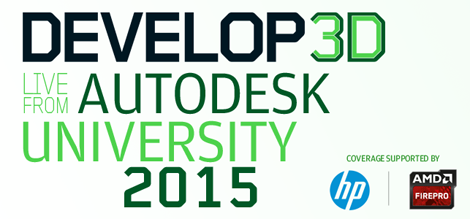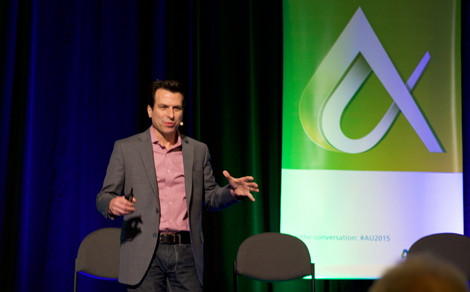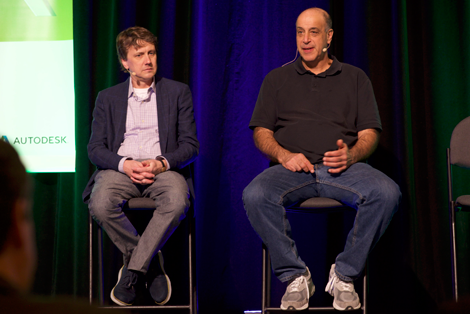
As is traditional practice at AU, Autodesk held an afternoon session featuring key executives to give an overview of the mainstage keynotes and to be on hand for the international press to ask questions.
This year the Q&A sessions featured: Andrew Anagnost, senior VP of industry, strategy and marketing, chief technology officer Jeff Kowalski, and president and CEO Carl Bass.
The session opened with Anagnost picking out the customer stories an underlying messages from Kowalski and Bass’ Keynotes, highlighting the work that Autodesk has been doing with Airbus on computer generated solutions to engineering problems.
The big message was that this is a fundamentally different way for design and looking forward, where we can all start to work with computers to solve problems, as opposed to merely document.

Andrew Anagnost, Autodesk senior VP of industry, strategy and marketing, leading the press Q+A
Anagnost is a key player at Autodesk, where he has been overseeing the company’s move to a cloud and subscription-based model, a business model that Autodesk will truly ‘flick the switch’ on next year, as from July 2016, products will only be available on Autodesk Subscription.
From talking with dealers at the event, many were hastily trying to position themselves to survive on Autodesk’s lower-margin business model. The two things they could agree on was that they needed to sell more ‘services’ and that there will be fewer Autodesk resellers in the future.
Anagnost refused to come up with a number when asked how many Value Added Resellers (VARs) would be lost through this business model change, but agreed there would be consolidation.
On the fate of resellers, he replied, “There are already partners out there that have moved over 60 per cent of their new run rate to our new business model. What they are asking from us is for more stuff like Forge, they want development platforms and they want a way to connect processes and make things work and deploy these new types of solutions in their customers.
They are itching to do this, these are our best partners. These are the partners we are going to invest in and build our ecosystem.
“You are right, in the new world where we are moving towards subscription for everything, some partners who made their business from just turning the crank, answering phone calls… I think it’s going to be tough for them, that’s the reality. We told them over and over. Our best partners are already figuring out what they need, they are asking us for it and we are delivering it.
“The more capable our partners get with the Forge platform, the more business they are going to have.“
Next year there will be a seismic shift in the Autodesk business model, altering how much you pay, how you pay and where you get software.
For those that rely on the local reseller channel this could impact any level of ‘free’ help on offer, access to on-site demonstrations, training and potentially a change in reseller.
Anagnost seems to be blurring the lines on what Autodesk wants from its future channel, more developer than product sales.

Chief technology officer Jeff Kowalski, and president and CEO Carl Bass
CEO and CTO
The main act for this Q&A session was the appearance of Kowalski and Bass side by side. As usual the the questions were varied and ranged from the aims of the new Dreamcatcher technology to sales issues in China and Russia.
On the subject of sustainability, the pair were asked on the the usage of Autodesk’s sustainability analysis tools and if it’s an important part of Autodesk’s sales. CEO Bass, replied: “I wouldn’t look as our investment in Sustainability as one which is based on a return, financially speaking. It’s one of the areas where we think there are big problems in the world and there are a number of things that we can contribute.
“This can range from energy analysis of building to great examples such as ‘lightweighting’ parts with Dreamcatcher. There is an enormous positive long term effect in deploying this technology. This helps our customers, which is good business.”
Kowalski added: “We have given customers tools so they can understand the impact of designs, assess performance, operational cost and optimise all of that before hey commit to a final design.
“We are now looking to take back the actual ‘in use’ operation data back into the model, so they can understand the discrepancies and ‘debug’ the design.”
Both Kowalski and Bass were looking forward to hearing what was going to come out from the Paris COP21 summit. They were probably very happy with the result.
On the development of Autodesk’s 3D print platform Spark, and hardware, Ember, Kowalski commented: “ There are three components to Spark – the API, the reference printer the Ember and an investment fund to boot up the ecosystem.
“We were successful in transferring the conversation around 3D printing from ‘trinket’ making to actual additive industrial manufacturing. The printer we developed is actually capable of producing real production parts, it’s very high resolution and open sourced.
“Through the fund we got to see nearly everything that was about to happen in the market and have meaningful impact.”
Bass added: “As a side note here, the difference between Autodesk the software giant and Autodesk the hardware start-up, the other day we had one of those hardware start-up ecstatic nightmares, that take place simultaneously, when someone came to use and asked for 1,000 ember printers. We had an incredible desire to say yes but had no capacity to produce them!
“It’s giving us a different lens into how some of our customers live. Just to add to Jeff’s point about trinkets, we have moved from talking trinkets to Airbus flying a 3D printed part.”
On the topic of Autodesk’s acquisition strategy, Bass explained: “We tend to do 10-15 acquisitions a year, and I put them in 3 buckets: small, medium and large.
“The smallest category is a team and technology, people who are passionate, educated, love the thing they are doing and know a lot about it. The second one are folks that have a product, or almost have a product and the third is a company, that has multiple products, established and mature. Many of our acquisitions fall into the first two buckets.
“When we have a desire to get into a market and the best way is to acquiring or ‘acquihire’ a team or buy a product in development to shorten our time to market. It’s fairly rare for us to actually buy a company”
When he fwas asked what the Autodesk will look like in 2020, Bass answered: “Our products will become indistinguishable. We will have a range of cloud-based products and services that people will put together in ways that makes sense for them, they will access and reconstruct that platform in their own way.
“The desktop ‘thing’ will now take place in the cloud.
“Look at Fusion 360 and PLM 360, they have front ends for input and almost all the computation happens on the other side of the wire. That’s the cloud-based world of products and services that all software companies will be in.”
On the move to the cloud, Bass thinks that mobility is becoming mainstream, an example being people increasingly not wanting to travel with their laptops. “With the advent of products like the MS Surface Pro and Apple iPad Pro, it’s becoming increasingly more obvious that tablets are taking over, even for people that use design software”.
He added that the super computer we have in our pocket is going to play an increasing role in cloud services.
From other answers we gleamed:
We heard that Autodesk hires young people to look at Autodesk solutions and interfaces with fresh eyes and then compare them to competitors products.
Bass admitted to owning a drone and has a similar outlook to them as 3D printers and trinkets. While the consumer market for drone is interesting, Bass thinks the big benefits are going to come from industrial uses. On the giant Apple campus being build in California, morning meetings are based on UAV video from the day before.
Building and Manufacturing are starting to blur, with modelling being used increasingly in the AEC space and digital fabrication becoming better understood and deployed onsite. AEC is becoming a manufacturing process and building are becoming assemblies.
On technology, Bass admits that he gets 98 per cent excited by most new technology but there’s always two per cent that ‘creeps him out’, should that be drones, biotechnology, 3D printing. ‘Bad people do bad things’ with any technology, he said.
Kowalski admitted that a few years ago they had taking a 3D printed gun to a conference in the UK and waved it around on stage to show technology can be used or abused.
Globally, a few questions opened up the challenge Autodesk faces around the world. Having been developing software in China for ten years and with many customers it’s ‘certainly not the easiest place to do business’. Meanwhile in Russia, the government recently banned state-owned firms from buying foreign-made software, to which Bass responded that all Government procurement is: “incredibly short sighted and about the most stupid thing that anyone can do in the IT realm, should that be for security concerns or to support the domestic software industry.”

What is Autodesk Forge?
At Autodesk University, Autodesk launched a new development platform (PaaS – Platform as a Service) and $100 million fund to assist the next generation of third party developers.
Forge runs on Amazon Web Services and on Autodesk’s own server centres, which are currently in development.
This cloud platform is a single place where Autodesk’s products and services are available for access by Third Party developers through APIs and SDKs.
Over the past five years Autodesk has been rewriting or creating new web-based platforms, such as 3D rendering, model collaboration and DWG read/write as componentized ‘web services’, which all of its applications can call on when functionality is needed. Now developers will be able to hook into Autodesk’s PaaS and integrate or build new applications to focus on specific markets.
The big wedge of money is there to attract start-ups and pay for development work in key areas that Autodesk is targeting.
The focus, we are told, will mainly be in the manufacturing segment, where Autodesk is hell bent on sprinkling Fusion amongst its competitor’s customers.
All our AU2015 coverage can be found online
Read about everything that happened at Autodesk University 2015 for free here
– Day 1 Live Blog – the opening day as it happened
– Day 2 Live Blog – the day as it happened
– Q+A with Autodesk top Brass – we got up close an personal about all the latest Autodesk news
– 5 Things we learned from AU2015 – some of the big stories and our predictions






